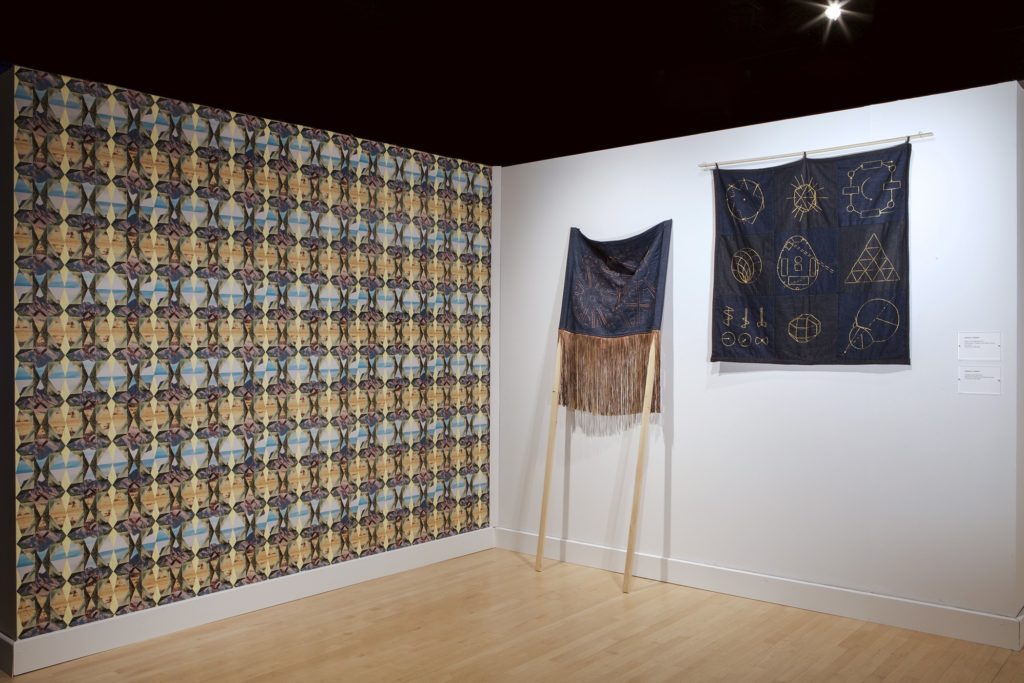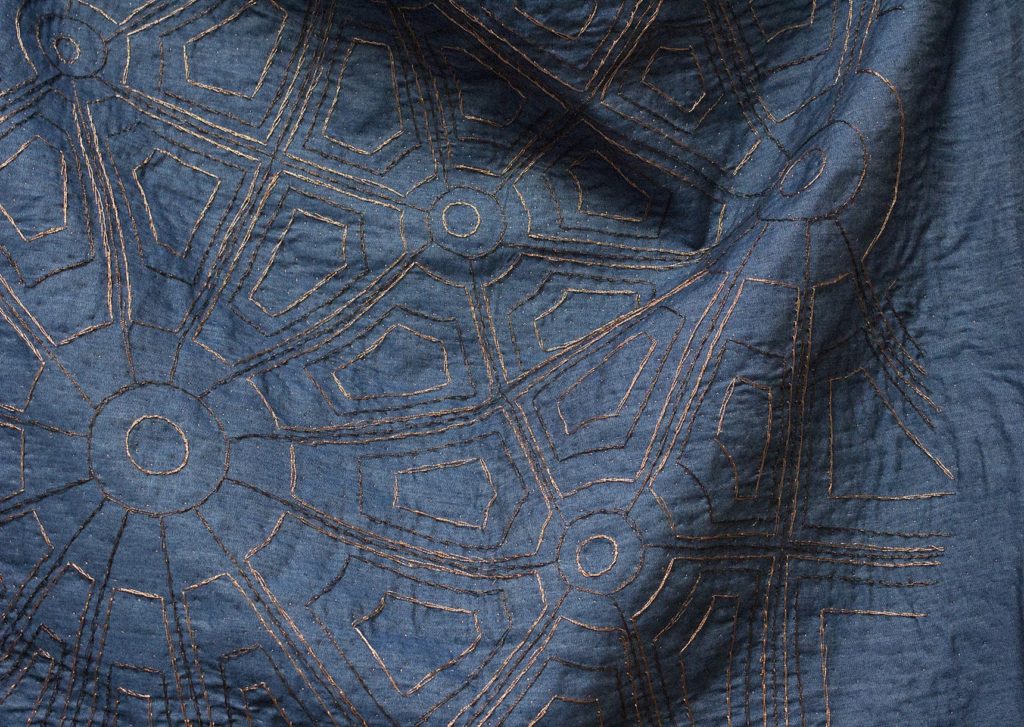WIP Artist Highlight: Sarah G. Sharp
For Sarah Sharp, textiles run in the family. Her great grandmother worked as a milner and lace tatter, and her stepmom was an avid crafter, teaching Sarah how to cross-stitch at a young age.
Now an interdisciplinary textile artist, Sarah has just finished up her Work in Progress Residency at the Textile Arts Center’s Manhattan studio. I sat down with Sarah in mid-November to discuss her practice and plans for her time at TAC.
The combination of a flexible studio space and display site inspired in new ways: “It’s interesting to think about; is it a display space or is it an ever-changing studio space? So I’m sort of letting it evolve.”
Sarah took this passion for art with her into college, studying at the California College of Arts in Oakland at first before transferring to Evergreen State College in Olympia, Washington. At Evergreen she studied film and printmaking, an interdisciplinary approach that remains core to her artistic practice.
While pursuing a graduate degree at SUNY Purchase, Sarah worked for the embroidery artist Elaine Reichek. This reintroduction to textiles proved seminal to her practice. Sarah explains:
“Eventually, textiles became a way for me to make sculptural objects, to activate different materials, and to almost remix culture.” Textiles allow her to reuse materials and make pieces that are impermanent. They can be transformed into large forms that are flexible, collapsible, and moveable."
In her recent series Whole Earth Systems, images and diagrams culled from the Whole Earth Catalog (WEC) are embroidered onto denim sourced from residencies in the Western and Southwestern United States. Sarah then assembles the textiles into sculptural works.
Founded by Stewart Brand in the late 1960s, the Whole Earth Catalog included product reviews, educational resources, and essays on a diverse array of topics, all organized non-hierarchically. Guest editors included Beat poet Anne Waldman and the Black Panthers. Sarah explains, “Culture and social information was conveyed through these Catalogs. And if you knew about it you could be in any part of the country and get the Catalog, so it operated similarly to the ways that different parts of the internet operate today. It was very American actually, but part of the counterculture. You could learn about spirituality, sexuality” all in one publication.

The link between concept and material is strong in Sarah’s work; diagrams and images curated from this non-hierarchical resource find new life through textiles, a discipline with its own radical histories of challenging social hierarchies.
With a practice primarily centered around found and reused materials, Sarah rarely spent time in commercial fabric stores. It wasn’t until she began teaching in Baltimore that she started spending time in Jo-ann Fabrics. During an autumn visit to the store, an abundance of of camouflage-printed fabrics and hunters’ shirting piqued her interest:
“I realized that they were being bought by people and made into actual clothing and objects for people to use hunting. I got curious about those fabrics, thinking about who’s in a fabric store in Baltimore county in Southwestern Maryland. It’s almost all women, though not entirely of course, who are engaging in this craft in the domestic sphere,” often making clothing “for someone else in their life who is going to take them into the outside world.”
The gendered dynamics of these “evocative materials” led to her Kinship series. By subverting the use of materials produced for hunting, the series considers: “at the edges of rural spaces, where suburbia meets rural-ness, how do these representations of nature get worked out, and how do they get inscribed with gender?”
Sarah grew up in Northern California, where she knew some people who went hunting for sport, and she was “totally and completely against it.” It wasn’t until she moved the Northern Vermont, where she lived for two years before coming to New York, that her perspective on hunting began to expand.

While working at the Vermont Studio Center, she met a lot of people there who hunted for subsistence. She explains, “They had a very deep and connected relationship to the land. They were thoughtful about the animals they chose and used all of the animal; there was a real relationship between hunting and survival.”
“If you’re trying to kill something, you have to get really close to it, so there’s this really sort of complicated relationship with the hunter and its prey. I’m interested in that as a metaphor. It was the first time that I really thought about hunting that way.”
Sarah teaches herself skills as she needs them. While the Whole Earth Systems series is all sewn, embroidered, and quilted by hand, she uses an embroidery machine for her ongoing Kinship series. The images throughout Kinship are based in what Sarah calls a “spiritual geometry,” designs that come out of spiritual practices and “evoke altered consciousness.” By producing images digitally and then embroidering them with the machine onto images of nature, her process layers new technologies to reference the natural realm.
Sarah continued developing Kinship throughout her WIP residency, creating small embroideries on quilt squares as sketches for larger pieces. Next steps include incorporating video and possible AR (augmented reality) into this textile vocabulary.
In addition, Sarah hosted a collaborative quilting event at the TAC Manhattan studio as an extension of the Tool Book Project, which raises funds for nonprofits. The project began as a discussion right after 2016 election, bringing together artists who were trying to figure out how to fit activism practices in with their art practices. Now in its third year, the annual publication gathers 20-40 artists through readings, exchanges, and talks. Its impact is clear: artists get use their practices to impact each other and make money for nonprofits that are especially threatened under the Trump administration.
With her “Tool Share, Quilting Circle” on November 16th, Sarah invited artists and community members to continue this discussion in anticipation of the forthcoming 2020 elections. Encouraging participants to work on a quilt together, it was her first time bridging her socially engaged practice with her more solitary studio practice.
Sarah finds inspiration in Bauhaus and early avant-garde design. She explains:
“I don’t know if they exactly come out in my work because my work is glitzier,” but many of their ideas and questions are core to her practice, such as “the utility of the material and abstract forms as a way to communicate things universally. I don’t think they do actually, I think they fail.”
Throughout Constructivism and the early twentieth century avant garde,"people had very strong ideas that abstract forms could convey meaning, for example if things were at angles they were more forceful, or that there might be gendered ideals attached to forms (round forms are more feminine). While I think we can understand what they’re getting at, I don’t think there’s such a thing as a universal language. I think that all things live within their context.”
Despite her disbelief in a universal language, Sarah works abstractly, intrigued by “the possibilities for a stripped down form to have some kind of forceful meaning.”
“I like the idea that the work I’m making can come from a very specific place inside of my—I might not even articulate all of its specificity—and its meaning can evolve with a different context or with the viewer.”
In addition to her studio practice, Sarah teaches new media classes for graduate and undergraduate students at the University of Maryland in Baltimore. Her advice to young artists? “You only need to know enough to be able to collaborate with someone else” While we often feel that we need to understand how to do everything on our own, there is power in knowledge exchange and collaboration.